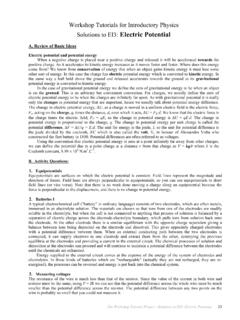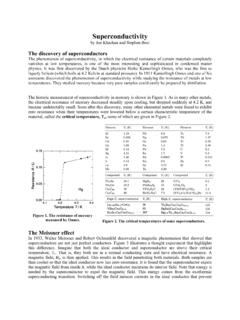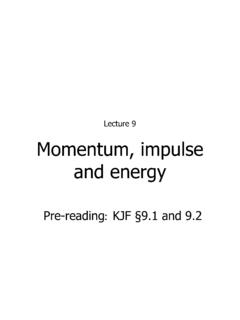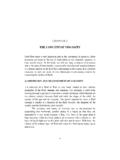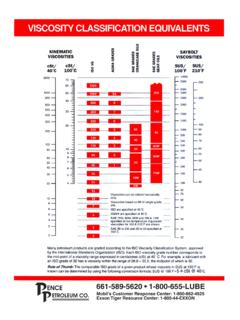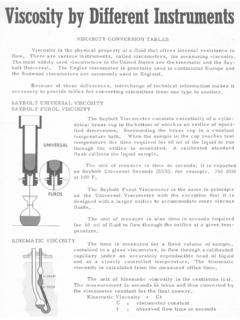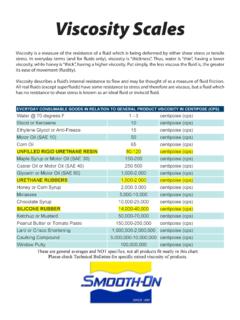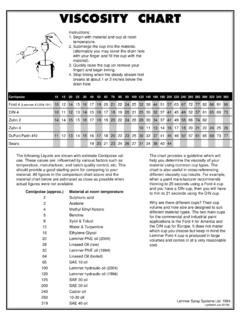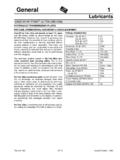Transcription of Viscosity and Poiseuille's Law
1 FLUID FLOW Viscosity Poiseuille's LAW ? Why do cars need different oils in hot and cold countries? Why does the engine runs more freely as it heats up? Have you noticed that skin lotions are easier to pour in summer than winter? Why is honey sticky? Viscous fluids tend to cling to a solid surface. Syrup and honey are more viscous than water. Grease is more viscous than engine oils. Liquids are more viscous than gases. Lava is an example of a very viscous material. ! When real fluids flow they have a certain amount of internal friction called Viscosity . It exists in both liquids and gases and is essentially a friction force between different layers of fluid as they move past one another.
2 In liquids the Viscosity is due to the cohesive forces between the molecules whilst in gases the Viscosity is due to collisions between the molecules. Coefficient of Viscosity When a fluid ( air) flows past a stationary wall ( table top), the fluid right close to the wall does not move. However, away from the wall the flow speed is not zero. So a velocity gradient exists. This is due to adhesive, cohesive and frictional forces. We find that the magnitude of this gradient (how fast the speed changes with distance) is characteristic of the fluid. This is used to define the coefficient of Viscosity (Greek letter eta). VISUAL PHYSICSS chool of PhysicsUniversity of SydneyAustra liaVISUAL PHYSICSS chool of PhysicsUniversity of SydneyAustra liaa03/p1/ 1 !
3 Fluid in contact with either surface is held to that surface by adhesive forces between the molecules of the fluid and surface. Therefore, the molecules at the surface of the stationary wall are at rest and the molecules at the surface of the moving plate will be moving with velocity v. The stationary layer of fluid in contact with the stationary wall will retard the flow of the layer just above it. This layer will retard the layer above and so on. Thus the velocity will vary linearly with distance above the stationary wall. The force required to move the plate at speed v is F A A = area of either plate F (v / L) (v / L) = velocity gradient The constant of proportionality for the fluid is called the coefficient of Viscosity F = A v / L The greater the coefficient of Viscosity , the greater the force required to move the plate at a velocity v.
4 This equation does not hold for all fluids. Viscous fluids that obey this equation are called newtonian fluids and = constant independent of stationary wallLFlow of a viscous fluidlow speedhigh speedplate moving with speed vXZlinear velocity gradientvz= (d / L)vvz= (v / L)ddvz= 0vz= va03/p1/ 2! the speed of flow. When does depend upon the velocity of flow the fluids are called non-newtonian. Blood is an example of a non-newtonian mixture because it contains corpuscles and other suspended particles. The corpuscles can deform and become preferentially oriented so that the Viscosity decreases to maintain the flow rate. Corn flour and water mixture is another non-newtonian fluid. ! Viscosity = (F / A)(L / v) ( )(m).
5 ( ) SI unit for Viscosity is A common unit is the poise P where 1 = 10 P 1 = 10-2 P Fluid ( ) water (0 C) water (20 C) water (100 C) white blood (37 C) ~4 blood plasma (37 ) ~ engine oil (AE10) ~ 200 air Viscosity is very temperature dependent Viscosity of a liquid decreases with increasing temperature. Viscosity of a gas increases with increasing temperature. ? Why can't you get all the dust off your car by just squirting water from a hose onto it? Why can't you simply remove dust just be blowing across the surface? Why does dust cling to a fast rotating fan? How can a leaf stay on a car moving at high speed?
6 A03/p1/ 3 ! Boundary layer When a fluid moves over a surface, there is a thin layer of the fluid near the surface which is nearly at rest. This thin layer is called the boundary layer. F Poiseuille's Law Inthrough pipes, the following factors are easy to isolate: Tthe pressure difference, the faster will be the flow. Tlonger pipe in the same time. Tnarrow pipe in the same time. This dependence is very marked. Theasily than glycerine. low of a fluid through a pipe trying to find out what factors control how fast fluids can flow he pressure difference between the ends of the pipe. The bigger he length of the pipe. More liquid will flow through a shorter than a he radius of the pipe. More liquid will flow through a wide than a e coefficient of Viscosity of the liquid.
7 Water flows much more a03/p1/ 4 he volume flow rate poiseuille s Law: laminar flow of a newtonian fluid through a pipevolume flow rate Q= dV/dtQ= dV/dt 2 RLp1p2 p= p1-p2Q= dV= p R4Q= dV= p R4parabolic velocity profilep1> p2 pressure drop along pipe energy dissipated (thermal) by friction between streamlines moving past each other! ! T Q = dV/dt f a fluid of Viscosity , through a pipe of radius R and length L, when dV/dt = Q = p R4 / (8 L) his is known as Poiseuille's law. Poiseuille's law only applies to odriven by a pressure difference p is given by Tnewtonian fluids. Non-newtonian liquids do not obey Poiseuille's lawbecause their viscosities are velocity dependent. The assumption of streamlined (laminar) flow is built in to Poiseuille's law.
8 If turbulence occurs than you must be very careful about using Poiseuille's law to calculate flow rates. If turbulence does occur in the flow then the volume flow rate is dramatically reduced. 8 Ldt8 Ldta03/p1/ 5 Alternative view of Poiseuille's Law Consider an electrical circuit in which a potential V between the ends of a resistance R results in a current I. Then the flow is determined by the ratio of potential to resistance. flow (current) = potential / resistance I = V / R Poiseuille's Law can be arranged in this form flow = potential / resistance Q = p / (8 L / R 4) flow Q potential p resistance (8 L / R 4) resistance L resistance resistance (1 / R 4) Just as electrical energy is dissipated when an electrical current flows, energy is dissipated when a fluid flows through a pipe.
9 In the electrical circuit this is manifest by the drop in potential around the circuit whereas for the flow in the pipe there is a drop in pressure along the pipe. Flow of a viscous newtonain fluid through a pipeVelocity ProfileAdhesive forces between fluid and surface fluid stationary at surfaceParabolic velocityprofileCohesive forces between molecules layers of fluid slide past each other generating frictional forces energy dissipated (like rubbing hands together) a03/p1/ 6 ? Why should turbulence mean that the volume rate of flow is less than in streamlined flow? When a builder designs the drainage system for the roof of a house, what factors should influence the choice of the size of the downpipe? Would he be correct in basing his calculations on Poiseuille's Law?
10 In an experiment water rose by capillary attraction through two columns of soils, one with coarse grains and the other with fine gains. It was observed that the water rose faster in the column with the coarser grains. Can you say why this is so? The volume flow rate Q is very sensitive to changes in radius of the pipe R since Q R 4 this fact and leads to many situations in which Poiseuille's law has important effects. Irrigation pipes It is uneconomical to use spray irrigation too far from a river since the resistance of a pipe increases with its length, and you need too big a pump. Pipes from Warragamba Dam Here p and L are fixed (by geography), and the volume rate of flow is fixed by the requirements of the population of Sydney.
